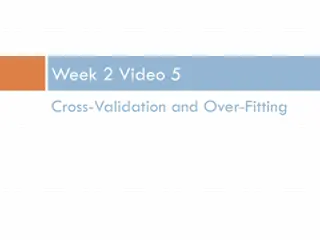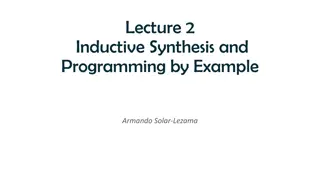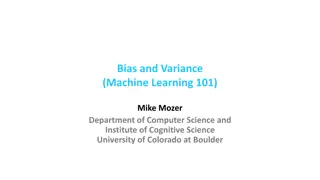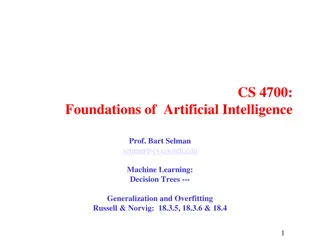Understanding Overfitting and Inductive Bias in Machine Learning
Overfitting can hinder generalization on novel data, necessitating the consideration of inductive bias. Linear regression struggles with non-linear tasks, highlighting the need for non-linear surfaces or feature pre-processing. Techniques like regularization in linear regression help maintain model simplicity while improving accuracy. Exploring hypothesis spaces and selecting appropriate polynomial orders can aid in addressing overfitting.
Download Presentation

Please find below an Image/Link to download the presentation.
The content on the website is provided AS IS for your information and personal use only. It may not be sold, licensed, or shared on other websites without obtaining consent from the author. Download presentation by click this link. If you encounter any issues during the download, it is possible that the publisher has removed the file from their server.
E N D
Presentation Transcript
Overfit and Inductive Bias: How to generalize on novel data CS 270 - Inductive Bias 1
Non-Linear Tasks Linear Regression will not generalize well to the task below Needs a non-linear surface Could use one of our future models Could also do a feature pre-process like with the quadric machine For example, we could use an arbitrary polynomial in x Thus, it is still linear in the coefficients, and can be solved with delta rule What order polynomial should we use? Overfit issues can occur y x CS 270 - Inductive Bias 2
Overfitting Typically try to learn a model just complex enough to do well and no more complex than that CS 270 - Inductive Bias 3
Linear Regression Regularization Keep the model as simple as possible while still being accurate For regression, keep the function smooth Regularization approach: updated loss function Minimize F(h) = Error(h) + Complexity(h) Tradeoff training accuracy vs complexity Ridge Regression (L2 regularization) Minimize: F(w) = TSS(w) + ||w||2 = (predictedi actuali)2 + wi2 Gradient of F(w): Dwi=c(t-net)xi-lwi (Weight decay, not bias weight) Linear regression with just the original features cannot overfit, but regularization useful when the features are a non-linear transform of the initial features (e.g. polynomials in x) Lasso regression uses an L1 vs an L2 weight penalty: wi and thus decay is just since derivative drops weight from the term Sometimes called shrinkage models decrease/shrink weights CS 270 - Inductive Bias 4
Ridge Regression Example CS 270 - Inductive Bias 5
Hypothesis Space The Hypothesis space H is the set of all possible models h which can be learned by the current learning algorithm e.g. Set of possible weight settings for a perceptron Restricted hypothesis space Can be easier to search May avoid overfit since they are usually simpler (e.g. linear or low order decision surface) Often will underfit e.g linear models Unrestricted Hypothesis Space Can represent any possible function and thus can fit the training set well Includes most of the powerful ML algorithms However, mechanisms must be used to avoid overfit CS 270 - Inductive Bias 6
Avoiding Overfit Regularization: any modification we make to learning algorithm that is intended to reduce its generalization error but not its training error Occam s Razor William of Ockham (c. 1287-1347) Favor simplest explanation which fits the data General Key: Focus on patterns/rules that really matter and ignore others Simplest accurate model: accuracy vs. complexity trade-off. Find h H which minimizes an objective function of the form: F(h) = Error(h) + Complexity(h) Complexity could be number of nodes, size of tree, magnitude of weights, etc. More Training Data (vs. overtraining on same data) Data set augmentation Fake data, Can be very effective, Jitter, but take care Denoising add random noise to inputs during training can act as a regularizer Adding noise to models. e.g. (Random Forests, Dropout , discuss with ensembles) Early Stopping Very common regularization approach: Start with simple model (small parameters/weights) and stop training as soon as we attain good generalization accuracy (and before parameters get large) Common early stopping approach is to use a validation set (next slide) We will discuss other model specific approaches with specific models CS 270 - Inductive Bias 7
Early Stopping/Model Selection with a Validation Set SSE Validation Set Training Set Epochs (new h at each) There is a different model h after each epoch Select a model in the area where the validation set accuracy flattens Keep bssf (Best Solution So Far). Once you go w epochs with no improvement stop and use the parameters at the bssfw epochs ago. The validation set comes out of training set data Still need a separate test set to use after selecting model h to predict future accuracy Simple and unobtrusive, does not change objective function, etc Can be done in parallel on a separate processor Can be used alone or in conjunction with other regularization approaches CS 270 - Inductive Bias 8
Inductive Bias The approach used to decide how to generalize novel cases A common approach is Occam s Razor The simplest hypothesis which explains/fits the data is usually the best Many other rationale biases and variations CS 270 - Inductive Bias 9
** Inductive Bias Challenge Question ** The approach used to decide how to generalize novel cases A common approach is Occam s Razor The simplest hypothesis which explains/fits the data is usually the best Many other rationale biases and variations All the variables in the shown data set are binary A = True, = False You be the machine learner, learn the data set, and decide your inductive bias ABC Z AB C Z ABC Z AB C Z A B C Z You then get the new input B C. What is your generalized output? A. Z is false B. Z is true C. I can t decide A BC ? CS 270 - Inductive Bias 10
One Definition for Inductive Bias Inductive Bias: Any basis for choosing one generalization over another, other than strict consistency with the observed training instances Sometimes just called the Bias of the algorithm (don't confuse with the bias weight of a neural network). Bias-Variance Trade-off Will discuss in more detail when we discuss ensembles CS 270 - Inductive Bias 11
Inductive Bias Approaches Restricted Hypothesis Space - Can just try to minimize error since hypotheses are already simple Linear or low order threshold function k-DNF, k-CNF, etc. Low order polynomial Preference Bias Use unrestricted hypothesis space, but prefer one hypothesis over another even though they have similar training accuracy Occam s Razor Smallest DNF representation which matches well Shallow decision tree with high information gain Neural Network with low validation error and small magnitude weights CS 270 - Inductive Bias 12
Need for Bias 22n Boolean functions of n inputs x1 0 0 0 0 1 1 1 1 x2 0 0 1 1 0 0 1 1 x3 0 1 0 1 0 1 0 1 Class 1 1 1 1 ? Possible Consistent Function Hypotheses CS 270 - Inductive Bias 13
Need for Bias 22n Boolean functions of n inputs x1 0 0 0 0 1 1 1 1 x2 0 0 1 1 0 0 1 1 x3 0 1 0 1 0 1 0 1 Class 1 1 1 1 ? Possible Consistent Function Hypotheses 1 1 1 1 0 0 0 0 CS 270 - Inductive Bias 14
Need for Bias 22n Boolean functions of n inputs x1 0 0 0 0 1 1 1 1 x2 0 0 1 1 0 0 1 1 x3 0 1 0 1 0 1 0 1 Class 1 1 1 1 ? Possible Consistent Function Hypotheses 1 1 1 1 1 1 1 1 0 0 0 0 0 0 0 1 CS 270 - Inductive Bias 15
Need for Bias 22n Boolean functions of n inputs x1 0 0 0 0 1 1 1 1 x2 0 0 1 1 0 0 1 1 x3 0 1 0 1 0 1 0 1 Class 1 1 1 1 ? Possible Consistent Function Hypotheses 1 1 1 1 1 1 1 1 1 1 1 1 1 1 1 1 1 1 1 1 1 1 1 1 1 1 1 1 1 1 1 1 1 1 1 1 1 1 1 1 1 1 1 1 1 1 1 1 1 1 1 1 1 1 1 1 1 1 1 1 1 1 1 1 0 0 0 0 0 0 0 0 1 1 1 1 1 1 1 1 0 0 0 0 1 1 1 1 0 0 0 0 1 1 1 1 0 0 1 1 0 0 1 1 0 0 1 1 0 0 1 1 0 1 0 1 0 1 0 1 0 1 0 1 0 1 0 1 Without an Inductive Bias we have no rationale to choose one hypothesis over another and thus a random guess would be as good as any other option. CS 270 - Inductive Bias 16
Need for Bias 22n Boolean functions of n inputs x1 0 0 0 0 1 1 1 1 x2 0 0 1 1 0 0 1 1 x3 0 1 0 1 0 1 0 1 Class 1 1 1 1 ? Possible Consistent Function Hypotheses 1 1 1 1 1 1 1 1 1 1 1 1 1 1 1 1 1 1 1 1 1 1 1 1 1 1 1 1 1 1 1 1 1 1 1 1 1 1 1 1 1 1 1 1 1 1 1 1 1 1 1 1 1 1 1 1 1 1 1 1 1 1 1 1 0 0 0 0 0 0 0 0 1 1 1 1 1 1 1 1 0 0 0 0 1 1 1 1 0 0 0 0 1 1 1 1 0 0 1 1 0 0 1 1 0 0 1 1 0 0 1 1 0 1 0 1 0 1 0 1 0 1 0 1 0 1 0 1 Inductive Bias guides which hypothesis we should prefer? What happens in this case if we use simplicity (Occam s Razor) as our inductive Bias (preference bias)? CS 270 - Inductive Bias 17
Learnable Problems Raster Screen Problem Pattern Theory Regularity in a task Compressibility Don t care features and Impossible states Interesting/Learnable Problems What we actually deal with Can we formally characterize them? Learning a training set vs. generalizing A function where each output is set randomly (coin-flip) Output class is independent of all other instances in the data set Computability vs. Learnability (Optional) CS 270 - Inductive Bias 18
Computable and Learnable Functions Can represent any function with a look-up table (Addition) Finite function/table Fixed/capped input size Infinite function/table arbitrary finite input size All finite functions are computable Why? Infinite addition computable because it has regularity which allows us to represent the infinite table with a finite representation/program Random function outputs are set randomly Can we compute these? Can we learn these? Assume learnability means we can get better than random when classifying novel examples Arbitrary functions Which are computable? Arbitrary functions Which are learnable? CS 270 - Inductive Bias 19
Computability and Learnability Finite Problems Finite problems assume finite number of mappings (Finite Table) Fixed input size arithmetic Random memory in a RAM Learnable: Can do better than random on novel examples CS 270 - Inductive Bias 20
Computability and Learnability Finite Problems Finite problems assume finite number of mappings (Finite Table) Fixed input size arithmetic Random memory in a RAM Learnable: Can do better than random on novel examples Finite Problems All are Computable Learnable Problems: Those with Regularity CS 270 - Inductive Bias 21
Computability and Learnability Infinite Problems Infinite number of mappings (Infinite Table) Arbitrary input size arithmetic Halting Problem (no limit on input size) Do two arbitrary strings match CS 270 - Inductive Bias 22
Computability and Learnability Infinite Problems Infinite number of mappings (Infinite Table) Arbitrary input size arithmetic Halting Problem (no limit on input size) Do two arbitrary strings match Infinite Problems Learnable Problems: A reasonably queried infinite subset has sufficient regularity to be represented with a finite model Computable Problems: Only those where all but a finite set of mappings have regularity CS 270 - Inductive Bias 23
No Free Lunch Any inductive bias chosen will have equal accuracy compared to any other bias over all possible functions/tasks, assuming all functions are equally likely. If a bias is correct on some cases, it must be incorrect on equally many cases. Is this a problem? Random vs. Regular Anti-Bias? (even though regular) The Interesting Problems subset of learnable? Are all functions equally likely in the real world? CS 270 - Inductive Bias 24
Interesting Problems and Biases All Problems Problems with Regularity Interesting Problems Inductive Bias Inductive Bias PI Inductive Bias Inductive Bias Inductive Bias CS 270 - Inductive Bias 25
More on Inductive Bias Inductive Bias requires some set of prior assumptions about the tasks being considered and the learning approaches available Tom Mitchell s definition: Inductive Bias of a learner is the set of additional assumptions sufficient to justify its inductive inferences as deductive inferences We consider standard ML algorithms/hypothesis spaces to be different inductive biases: C4.5 (Greedy best attributes), Backpropagation (simple to complex), etc. CS 270 - Inductive Bias 26
Which Bias is Best? Not one Bias that is best on all problems Our experiments Over 50 real world problems Over 400 inductive biases mostly variations on critical variable biases vs. similarity biases Different biases were a better fit for different problems Given a data set, which Learning model (Inductive Bias) should be chosen? CS 270 - Inductive Bias 27
Automatic Discovery of Inductive Bias Defining and characterizing the set of Interesting/Learnable problems To what extent do current biases cover the set of interesting problems Automatic feature selection Automatic selection of Bias (before and/or during learning), including all learning parameters Dynamic Inductive Biases (in time and space) Combinations of Biases Ensembles, Oracle Learning CS 270 - Inductive Bias 28
Dynamic Inductive Bias in Time Can be discovered as you learn May want to learn general rules first followed by true exceptions Can be based on ease of learning the problem Example: SoftProp From Lazy Learning to Backprop CS 270 - Inductive Bias 29
Dynamic Inductive Bias in Space CS 270 - Inductive Bias 30
ML Holy Grail: We want all aspects of the learning mechanism automated, including the Inductive Bias Outputs Just a Data Set or just an explanation of the problem Automated Learner Hypothesis Input Features CS 270 - Inductive Bias 31
BYU Neural Network and Machine Learning Laboratory Work on Automatic Discover of Inductive Bias Proposing New Learning Algorithms (Inductive Biases) Theoretical issues Defining the set of Interesting/Learnable problems Analytical/empirical studies of differences between biases Ensembles Wagging, Mimicking, Oracle Learning, etc. Meta-Learning A priori decision regarding which learning model to use Features of the data set/application Learning from model experience Automatic selection of Parameters Constructive Algorithms ASOCS, DMPx, etc. Learning Parameters Windowed momentum, Automatic improved distance functions (IVDM) Automatic Bias in time SoftProp Automatic Bias in space Overfitting, sensitivity to complex portions of the space: DMP, higher order features CS 270 - Inductive Bias 32
Your Project Proposals Examples Look at Irvine Data Set to get a feel of what data sets look like Stick with supervised classification problems for the most part for the project proposals Tasks which interest you Too hard vs Too Easy Data should be able to be gathered in a relatively short time And, want you to have to battle with the data/features a bit See description in Learning Suite Remember your example instance! CS 270 - Inductive Bias 33
Feature Selection, Preparation, and Reduction Learning accuracy depends on the data! Is the data representative of future novel cases - critical Relevance Amount Quality Noise Missing Data Skew Proper Representation How much of the data is labeled (output target) vs. unlabeled Is the number of features/dimensions reasonable? Reduction CS 270 - Inductive Bias 34
Gathering Data Consider the task What kinds of features could help Data availability Significant diversity in cost of gathering different features More the better (in terms of number of instances, not necessarily in terms of number of dimensions/features) The more features you have the more data you need Data augmentation, Jitter Increased data can help with overfit handle with care! Labeled data is best If not labeled Could set up studies/experts to obtain labeled data Use unsupervised and semi-supervised techniques Clustering Active Learning, Bootstrapping, Oracle Learning, etc. CS 270 - Inductive Bias 35
Feature Selection - Examples Invariant Data For character recognition: Size, Rotation, Translation Invariance Especially important for visual tasks Chess board features Is vector of board state invariant? Character Recognition Class Assignment Example Assume we want to draw a character with an electronic pen and have the system output which character it is What features should we use and how would we train/test the system? CS 270 - Inductive Bias 36
When to Gather More Data When trying to improve performance, you may need More Data Better Input Features Different Machine learning models or hyperparameters Etc. One way to decide if you need more/better data Compare your accuracy on training and test set If bad training set accuracy then you probably need better data, features, noise handling, etc., or you might need a different learning model/hyperparameters If test set accuracy is much worse than training set accuracy then gathering more data is usually a good direction, though overfit or learning model/hyperparameters could still be a major issue CS 270 - Inductive Bias 37























